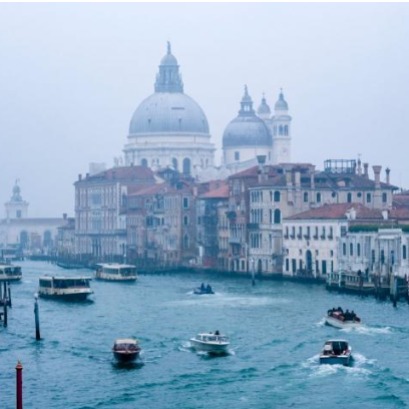
An inverted forest of millions of trees has held Venice for more than 1600 years
It is an millenary engineering work. For more than 1,600 years, Venice remains firm thanks to a unique foundation system in the world. These are millions of wooden posts stuck with the tip down in the muddy background of the lagoon. This base, which looks like an inverted forest, is composed of aler, oak, aliso, pine, fir and elmo. Thanks to this millenary engineering work, the city was officially founded on March 25, 421. Taking advantage of the laws of physics, monumental buildings have been built on land that seemed unstable. Only Rialtos bridge rests on 14,000 piles, while the Basilica of San Marcos sits over 10,000 oaks. No one knows how many wooden posts there are in total under the entire city, but the Venetian foundations have more than 16 centuries fulfilling their function, unlike modern materials such as concrete or steel, which have a projected life of 50 years on average as according to Alexander Puzrin, professor of geomechanics and geosystem engineering at the Federal Polytechnic University of Zúric.
A masterpiece of traditional engineering Battipali, workers specialized in the placement of posts, played a fundamental role. They stuck the posts by hand, singing to maintain rhythm and morals. His work was so recognized that he left popular Venetian expressions still in force, as I na Testa da Booter Pŕi, which means he has a head of knocking down piles and is used to describe someone clumsy. The piles were placed from the edge to the center, with a density of nine per square meter in a spiral. On them were installed beams or wooden planks, and finally, the stone of the building. To guarantee a constant wood supply, the Republic of Venice implemented pioneering forest conservation practices. In 1111, the first Italian document was recorded on sustainable forest management, in the FEMEME Valley, which allowed to preserve its forests until today. Stability under a threat controlled Venice solidity is not only due to wood. It is the combination of wood, water and mud that maintains stability. Although bacteria affect wood even in the absence of oxygen, the process is very slow. In addition, the water occupies the empty spaces and the mud maintains the pressure, which prevents structural collapse. Recent studies, such as that made by the universities of Padua and Venice, show that the wood has damage, but the system continues to work. The bell tower of the Church of Frari, for example, has sunk 1 millimeter per year since 1440. Despite this, the structure remains stable, thanks to the original engineering and the environment that protects it. Although during the nineteenth and twentie earthquakes However, as experts warn, it is not viable to build entire wooden cities. Since more than 1,600 years ago, Venice remains firm thanks to a unique foundation system in the world. These are millions of wooden posts stuck with the tip down in the muddy background of the lagoon. This base, which seems like an inverted forest, is composed of Alerce, Roble, Aliso, Pino, Apute and Olmo. Thank this millenary engineering work, the city was officially founded on March 25 of the year 421. Taking advantage of the laws of physics, monumental buildings have been built in a land that seemed unstable. Only Rialtos bridge rests on 14,000 piles, while the Basilica of San Marcos sits over 10,000 oaks. No one knows how many wooden posts there are in total under the entire city, but Venetian foundations have more than 16 centuries fulfill Geomechanics and Geosystems Engineering at the Federal Polytechnic University of Zúric. A masterpiece of traditional engineering Battipali, workers specialized in the placement of posts, played a fundamental role. They stuck the posts by hand, singing to maintain rhythm and morals. His work was so recognized that he left popular Venetian expressions still in force, such as you ŕ na Testa da Bater Pŕi, which means has a head of knocking down piles and is used to describe someone clumsy. The piles were placed from the edge to the center, with a density of nine per meter square in a spiral. On them were installed beams or wooden planks, and finally, the stone of the building. To guarantee a constant wood supply, the Republic of Venice implemented pioneering forest conservation practices. In 1111, the first Italian document was recorded on sustainable forest management, in the FEMEME Valley, which allowed to preserve its forests until today. Stability under a threat controlled Venice solidity is not only due to wood. It is the combination of wood, water and mud that maintains stability. Although bacteria affect wood even in the absence of oxygen, the process is very slow. In addition, the water occupies the empty spaces and the mud maintains the pressure, which prevents structural collapse. Recent studies, such as that made by the universities of Padua and Venice, show that the wood has damage, but the system continues to work. The bell tower of the Church of Frari, for example, has sunk 1 millimeter per year since 1440. Despite this, the structure remains stable, thanks to the original engineering and the environment that protects it. Although during the nineteenth and twentie earthquakes However, as experts warn, it is not viable to build entire wooden cities. Since more than 1,600 years ago, Venice remains firm thanks to a unique foundation system in the world. These are millions of wooden posts stuck with the tip down in the muddy background of the lagoon. This base, which seems like an inverted forest, is composed of Alerce, Roble, Aliso, Pino, Apute and Olmo. Thank this millenary engineering work, the city was officially founded on March 25 of the year 421. Taking advantage of the laws of physics, monumental buildings have been built in a land that seemed unstable. Only Rialtos bridge rests on 14,000 piles, while the Basilica of San Marcos sits over 10,000 oaks. No one knows how many wooden posts there are in total under the entire city, but Venetian foundations have more than 16 centuries fulfill Geomechanics and Geosystems Engineering at the Federal Polytechnic University of Zúric.
IT MAY INTEREST YOU
 Missions | The traditional National Wood Festival in November celebrates four decades of a popular gathering in San Vicente
Missions | The traditional National Wood Festival in November celebrates four decades of a popular gathering in San Vicente
The official announcement of the 4�th San Vicente National Wood Festival was made this Tuesday by the governor of Misiones, Hugo Passalacqua. The cultural and festive event will take place from November 5 to 9 at the Verón Gallardo Sports Center in San Vicente, Misiones, to celebrate four decades of history. The San Vicente National Wood Festival is a popular meeting point for the agroforestry and commercial community in the Alto Uruguay area, and is an opportunity for the forestry-industrial chain to expose its development and services. The festival includes cultural, artistic and economic promotion activities.
 Architecture with identity: university students from Argentina and Paraguay design and build with missionary wood
Architecture with identity: university students from Argentina and Paraguay design and build with missionary wood
The Faculty of Art and Design (FAyD) of the National University of Misiones (UNaM) hosted the inauguration of the first edition of “Yvyvyrá: territory, matter and architecture”, an international workshop that promotes learning, experimentation and architectural design using wood and other materials typical of the biomes of the Atlantic Forest (Paranaense Forest) and the Humid Chaco.
 The only tree in the middle of the Sahara desert that was vital for commercial and military routes
The only tree in the middle of the Sahara desert that was vital for commercial and military routes
The Ténéré Tree, a solitary acacia in the Sahara desert, became for centuries a beacon of life and reference for travelers In the vast Sahara desert, where aridity and silence dominate the landscape, there was a tree that stood alone, being a beacon of life and hope for travelers.




















